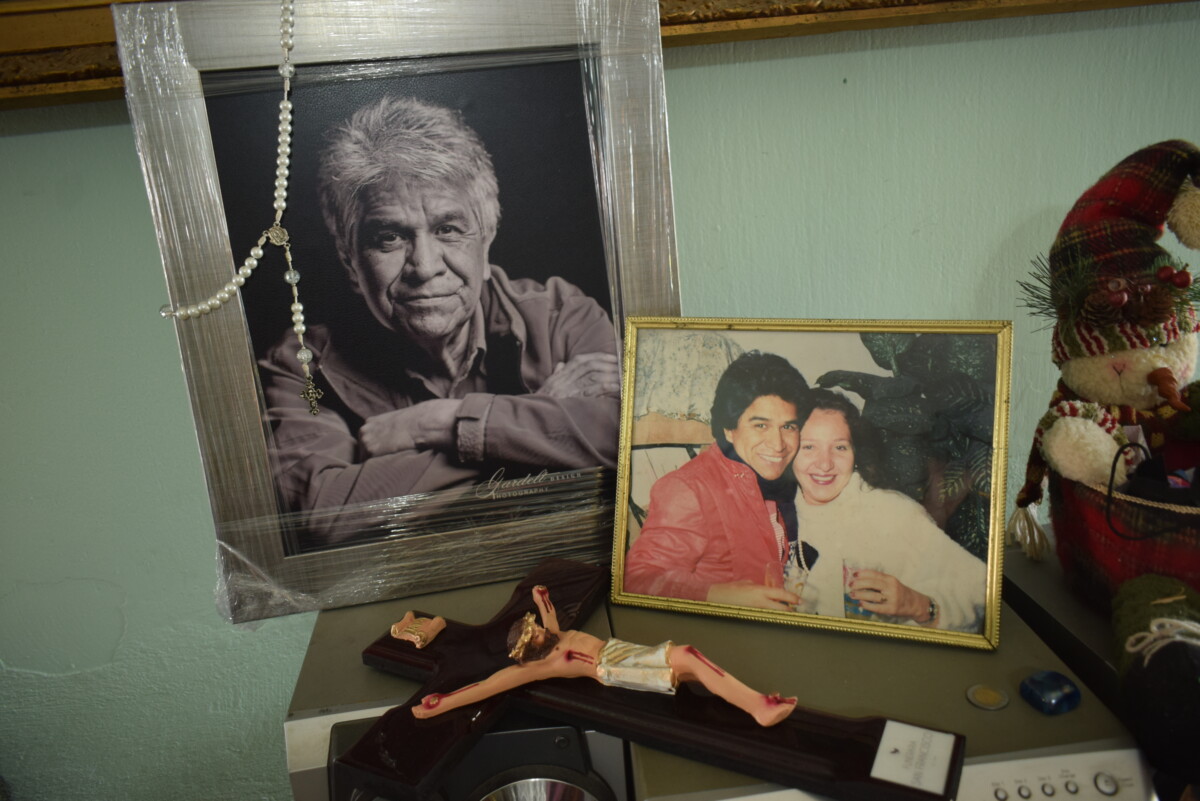«El Rojo»: a very political photographer, but with a social focus
Javier García Duarte was seen as pro-positivist and liberal, however, in his family he was very conservative.
Altar in honor of Javier García Duarte.
Jazmín Stengel: A tireless fighter who made Chapala his town, Francisco Javier «El Rojo» García Duarte (October 18, 1952 to January 21, 2021) was a man of many facets and of strong character, in solidarity with education, politics and Chapala society.
Javier, at a very young age, began working in a photography store as a salesman in Guadalajara. Later a man hired him to help him retouch the negatives in the darkroom and it was there where he learned the trade that would accompany him for the rest of his life: photography.
At the age of 26 or 27, according to his daughter Yuridia’s calculations, Francisco Javier married Irma Laura Álvarez González, who was only a few years younger, and a few months after their marriage their first offspring appeared: Ulises.
During his wife’s pregnancy, Javier lost his job, a situation that led him to partner with his brother Pedro to buy Foto Estudio del Lago, in Chapala. After several years of commuting from Guadalajara, Javier decided to move his family to Chapala in 1980, Yuridia recalled.
From then on, García Duarte’s life changed, and his insatiable social struggle began. He continued with his photography, creating a pictorial record of the events that happened at Lakeside during his career. At the end of the 80’s he began working for the Preparatoria por Cooperación de Chapala, teaching Sociology, Philosophy, and World History, among others.
«He used to fail me, but he smiled at me,» said the current Chapala president Alejandro de Jesús Aguirre Curiel, who was his student in high school, along with other important political figures and former presidents of Chapala, such as Joaquín Huerta and Alberto Alcantar.
As a teacher Javier was known for lecturing the class and giving oral exams, so it was difficult for those who did not take notes, Aguirre Curiel recalls. But despite being strict he always kept to topics of common interest.
Javier García left the institution when it achieved regionalization in 1994, as he did not have documentation to validate his knowledge or the level of academic studies required by the University of Guadalajara. Even so, he supported the movement and continued teaching at the then Chapala Academy.
Up to that time, due to his strong character and way of understanding the system, he was given his nickname. “He was always tough, that’s why they called him ‘El Rojo’,» explained Professor David Castellanos, a former classmate of his. He remembers Javier as a revolutionary and enterprising person, who fought tirelessly, even against the tide.
A few years later, together with the birth of the regional newspaper ‘El Charal’, between 1996 and 1997, the first opinion columns of García, already known as «El Rojo», were made public under the title «Miscelánea Política» (Political Miscellany). In 1999, for personal reasons, he decided to move to Javier Raygoza’s weekly «Página que sí se lee…», creating his second column «Código Rojo» (Code Red).
«El Rojo» also made citizen denunciations, took pictures of things that from his point of view were wrong, and published them with the desire to point out the situation and to make a change for the benefit of society, but his forte was always the politics of opinion.
«Rojo’s job was to see the political background that events could have,» commented Gilberto Padilla, reporter for Página magazine. «He helped us to interpret what we did not see. In his ‘calumnies’ as he called them, between nicknames and sarcasm he had a unique way of saying things.
«He was a teacher. He helped me understand politics, the actors within it and how parties are managed from their guts,» Padilla recalled. Padilla wasn’t the only one of his apprentices. Rojo supported and helped all the reporters who approached him for advice.
Even politicians were not indifferent to chatting with «El Rojo,» since many of them, being his former students, made him their advisor. Like Alejandro Aguirre, who during his first government used to seek advice from the master Javier before making crucial decisions.
Being a photographer, columnist and political advisor, García returned to teaching in 2007, this time as a teacher at the Colegio Nacional de Educación Profesional Técnica (Conalep) Ajijic – Chapala. He undertook a struggle for the rights of education workers, as they were hired and fired without legal justification, explained Professor Antonio Flores, a teacher at the same institution.
As general secretary of Conalep Ajijic-Chapala at that time, Francisco Javier achieved, in 2009, the signing of the first collective contract for teachers with the educational body. In other words, he dignified the education workers. «They owe him their labor stability,» said Flores.
Despite it costing him his job in 2013, Garcia managed to regularize the teachers of an entire region, including the 19 Conalep school campuses that existed in Jalisco until that date, and to improve their working conditions, regardless of the confrontations with the authorities that this entailed.
After the corresponding lawsuit, the court ordered the restitution of his job position. However, since the debt that the institution was supposed to reimburse was not settled, Rojo preferred to desist. «For me, I was proud to share that part,» exclaimed Antonio Flores, a witness during the legal process of the trial.
On the other hand, the journalistic events of Lakeside took an unexpected turn. In 2011 Semanario Laguna was created and with it, the last column of Javier García Duarte, ‘Desde el Sofá del Rojo’, which was in force until his last publication, in December 2021, days before he was hospitalized.
Rojo was a bit irregular in his publications and always arrived at the closing of the edition at the last moment, but with the intention of bringing the topics as up-to-date as possible. This allowed him to intermittently make video reviews, published by La Voz de la Ribera under his own nickname «El Rojo.”
Unfortunately, in 2019, due to the evolution of cell phone cameras, the sales of hisphoto studio dropped to the point of having to close it. Then in June 2021, barely half a year after commemorating the ninth anniversary of the death of his youngest son Nestor, his wife Irma passed away, and Rojo was never the same again.
Even so, Rojo continued to be a warrior in the face of life, and once again advised Alejandro Aguirre Curiel on his path to the presidency, serving as director of Social Communication during the 2021 campaign. «Rojo was the first person to know that I was going to run as a candidate, hours before my unveiling,» said Aguirre as a sign of the great appreciation and trust he had for the maestro.
García Duarte was considered a person of high level in the political life of the municipality, since as the mayor said, «He always wanted good governments for Chapala.” This is turn led him to collaborate in his political career with all parties and colors of the municipality, despite being a leftist.
One bad day, Javier went down to his usual meeting with friends for coffee, freshly bathed and with his jacket open. “That day it was very cold,» which made Rojo sick, according to his daughter Yuridia.
From that day on, the lung disease that Javier had been carrying since his time as a teacher began to give him trouble, and worsened until he had to be hospitalized in the Community Hospital of Jocotepec, at the end of 2021.
Yuridia received her father’s discharge on January 7. However, the next day he relapsed and was transferred to Guadalajara where he passed away on January 21, 2021, leaving six grandchildren, two children and a great legacy.
Translated by Sandy Britton.
Los comentarios están cerrados.
© 2016. Todos los derechos reservados. Semanario de la Ribera de Chapala








